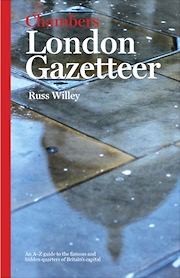Gazetteer
The London Gazetteer
Potted histories and profiles of London’s diverse localities
 To skip all this stuff and read about some places, please use the Index or click the search icon or the random button
To skip all this stuff and read about some places, please use the Index or click the search icon or the random button

The Gazetteer section was the nucleus of the original Hidden London website and still forms its largest part. It takes a look at a variety of the capital’s minor districts and localities, some in the outer boroughs and some tucked away in lesser-known corners of the city centre – focusing mainly on the ways in which they’ve developed and highlighting any special points of interest. If you know London well, you’ll already be familiar with many of the places featured here – but there should still be some you’ve never even heard of.
For a list of most of the localities featured on this site, please click here. Despite running to more than 650 pages, this online directory includes fewer than two-thirds of the places listed in Chambers London Gazetteer, from which the text here was originally drawn – although most pages have since been updated and expanded.
The Gazetteer section’s listings are devoted to lesser-known localities of varying sizes, but mostly diminutive. A ‘locality’ is any place (or station) named in one of the London street atlases, or on Ordnance Survey maps, or a park or road or estate with a distinct identity of its own.
Each listing generally includes an indication of where the place is and what it is like; perhaps some explanation of how it got its name, especially if this is interesting; a potted history of its development; and, if applicable, a few remarks on notable buildings, natural features, events and former residents, and selected artistic works that feature the place or were produced there.
The relevant postal district or postcode area is appended to each entry. Where there are two or more they are listed in approximate order of predominance (the same rule applies to the identification of parent boroughs). However, few areas in London have clearly defined borders, so this information should not be taken as gospel. For the same reason, a precise description of a locality’s extent is rarely attempted.
Population figures from the 2011 census are cited where one or more ‘output areas’ roughly match the extent of a listed place. However, electoral boundaries are frequently drawn so as to include a similar number of voters in each ward within a borough, so the data may not always give a true representation of a place’s magnitude. Demographic highlights are often provided within the text, ideally based on census data but alternatively from sources such as Ofsted reports – usually for primary schools because they tend to have a more localised catchment area than secondary schools.
The nearest station, tramstop or riverboat pier is usually given only when it has (or used to have) the same name as the place in question. Underground lines and mainline service providers are shown for each station, together with its fare zone(s).
Suggestions for further reading are given wherever possible and these range from slim pamphlets to multi-volume works. Preference is given to works still in print, when a direct link to Amazon is usually provided. Further reading suggestions should not be assumed to be the source of information featured on Hidden London, and certainly not the source of any errors in that information. (One grumpy local historian, who shall remain nameless, emailed to complain that Hidden London had sullied his name by making a questionable statement in an article while listing his book as ‘further reading’. His book is no longer mentioned here.)
Links are provided to selected relevant websites, especially if they are run as community resources rather than primarily as advertising vehicles. In the absence of a worthwhile community website, links are sometimes included to sites with information on aspects of local history or a district’s key attraction. If you run a local website that’s not mentioned on the relevant page of the Gazetteer section, please make contact to request its inclusion.
Visitors to Hidden London sometimes write to ask why such-and-such a locality isn’t included in the site’s Gazetteer. It will be eventually! It’s just a matter of time.
For the most part, the Gazetteer section isn’t continuously updated with changing information about the areas featured. However, revisions are made from time to time and the author will be happy to correct any errors that are drawn to his attention. Again, please use the contact form for this purpose.
